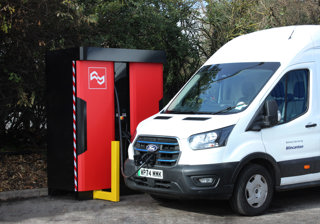This feature was taken from our Electric Fleet: Moving to Net Zero special report.

E-cargo bikes are becoming an increasingly common sight in UK towns and cities as the zero-emission vehicles begin to move from niche to mainstream use.
Analysis from Clean Cities earlier this year found there had been a 63% year-on-year rise in the use of e-cargo bikes by fleets in London, with major organisations leading the trend across the UK.
Amazon, for example, now operates e-cargo bikes from more than 40 cities in the UK and Europe, with its latest micromobility hub opening in Norwich this summer, while Evri plans to grow its fleet from 33 to 3,000 over the next decade.
“Pedal power will rev up our efforts to reimagine parcel deliveries in the UK as we aim to become the biggest operator of e-cargo bikes in the sector,” says Martijn De Lange, CEO at Evri.
However, it is not only mail and parcel delivery companies taking on the vehicles, as businesses from a broad range of sectors are taking advantage of their environmental, cost and efficiency benefits.
Here we look at the reasons behind the growth and what the vehicles mean to fleets:
2 E-cargo bikes are better for the environment
3 E-cargo bikes significantly cut urban journey times
4 They are significantly cheaper to run than vans
5 E-cargo bikes may require operational changes
1 E-cargo bikes are versatile
E-cargo bikes are particularly suited for use in dense urban areas, where there is a high concentration of work and individual trips are short.
“They can be used for a lot of different purposes,” says Mary McAlister, sales development executive at e-cargo bike solutions provider Zedify. “They can carry from a file to a filing cabinet, from a pen to a pallet. Some can carry up to 250kg and have a carrying capacity of up to 2,000 litres.”
E-cargo bikes are available in two general bodystyles; the traditional box bike, where the rider sits at the back of the bike with a large cargo box ahead of them, and the pedicab, which tends to have four wheels and the rider is seated at the front – providing protection from the weather – with the load behind them.
Current UK legislation states the motors on e-cargo bikes must be a maximum of 250w and able to provide assistance up to a speed of 15.5mph, at which point the motor cuts out.
The most common use of e-cargo bikes is unsurprisingly in the mail and parcel delivery industry, although trade body The Bicycle Association says there is also significant potential for them to be used in a wide range of other sectors, such as by tradesmen and service providers and the construction industry.
There are a growing number of examples of this. FM Conway, for example, uses e-cargo bikes to deliver construction materials of various sizes and weights, including bags of sand, to sites in London, while Veolia has recently added eight e-cargo bikes to its Hammersmith and Fulham Council street cleansing fleet.
Scott Edgell, general manager for Veolia South London, said the e-cargo bikes will improve service efficiencies as they are able to reach narrower routes such as the Thames Pathway, aiding the team to empty public litter bins and collect fly-tipped waste across the borough.
2 E-cargo bikes are better for the environment
Switching to an e-cargo bike from a diesel van has obvious environmental benefits – FedEx Express Europe has estimated it will avoid an estimated 22,000kg of CO2 per year by replacing six conventional internal combustion engine (ICE) vans with eight e-cargo bikes at its sites in London City and Hornsey (3,600kg per van).
Using e-cargo bikes will also significantly reduce the amount of NOx and particulates emitted into the local area.
“Companies are moving from diesel to electric vans and electric vans are great, but the battery in an electric van is much bigger than that in an e-cargo bike which means it takes a lot more resources to build,” says McAlister.
As part of its annual sustainability report, Zedify calculated how much CO2 e-cargo bikes created compared with electric and diesel vans using a well-to-wheel model, in which it took into account the impact of production of the vehicles and the fuel which powers the vehicle, as well as the tailpipe emissions.
It found that operating an e-cargo bike produced 15g/km of CO2, an electric van 82g/km and a diesel van 310g/km.
3 E-cargo bikes significantly cut urban journey times
One of the major benefits of using an e-cargo bike is the increased speed in which they can make journeys in urban areas compared with a van.
CitySprint says its e-cargo bikes can make deliveries up to 50% faster than a small van in urban areas, while FM Conway found the average speed of its bikes in London was 15.5mph, significantly quicker than the 9.2mph of its vans.
National motor factor GSF Car Parts, which supplies OE and aftermarkets parts, tools and other equipment to independent garages, national chains and the public, introduced two e-cargo bikes to its Tottenham branch earlier this year.
“London has notoriously bad traffic, low average speeds and lots of stop-start driving,” says Steve Horne, CEO of GSF Car Parts. “These bikes allow us to deliver to our customers in record time, beating the obstacles that such a large city usually poses with ease.
“Our delivery times are tumbling and customers are clearly impressed with this new super-fast delivery service.”
FM Conway says another benefit of using the bikes is that it can park its bikes much closer to their destinations than it could a van, increasing the operational efficiency further.
4 They are significantly cheaper to run than vans
The operating costs, such as fuel, of an e-cargo bike are significantly less than a van. With a retail price of between £5,000 and £16,000 dependent on type, size and options selected, they also have a significantly lower upfront price than a van.
There are further savings from not needing to pay congestion, emissions or parking charges.
An Energy Saving Trust study found an e-cargo bike’s operating costs (excluding funding/purchase price) were just £342 over a one-year/7,500-mile cycle, 77% less than a small electric van and 94% less than a small diesel van.
While organisations can purchase an e-cargo bike outright and manage it themselves, they also have the option to outsource to a specialist supplier such as Zoomo, which can provide the bikes, maintenance and software tools to allow the fleet to monitor location, repair history and uptime status.
5 E-cargo bikes may require operational changes
In some instances, an e-cargo bike will be a straight replacement for a van. In others, it could involve reorganisation of supply chains, including the use of micro-consolidation centres with the bikes used for the last part of the deliveries.
There are also a number of issues a fleet decision-maker needs to resolve when taking on e-cargo bikes.
These include where the bikes will be stored, what the potential routes will be, whether there will be an alternate mode of transport when riding a bike is not advisable such as in icy weather, and who will ride the vehicle.
Current regulations do not require a licence, vehicle registration or helmet, although an employer has the same duty of care to a user as it does a car or van driver.
The Bicycle Association has developed UK codes of conduct for cycle logistics riders and operators, and a minimum standard for cargo bike rider training.
Currently, compliance with both is on a voluntary basis, although the organisation is calling on the Government to endorse and publish these standards as the minimum expectation for cycle logistics operations in the public realm.
Decarbonising a fleet is not just about replacing an ICE vehicle with a like-for-like electric replacement – it may open the door to other, more operationally efficient transport modes.
In our new Electric Fleet: Moving to Net Zero special report, we look at the fleets that are already utilising flying drones, rolling robots or powered mobility such as e-cargo bikes and light vehicles, assessing use cases and considerations for organisations looking to pilot these options.
We also look ahead to forthcoming battery electric technology to evaluate its potential impact on fleet operations, with longer ranges and faster charging among the key benefits, as well as the potential of hydrogen, which is undergoing a number of Government-funded trials in the UK.
Other topics we investigate include the ongoing impact of the ZEV Mandate and how fleet managers need to be prepared to take advantage of any potential deals offered by manufacturers, and technology trends – including batteries – which will have an influence on fleet operations.
We also look at what fully-electric cars will hit the UK market over the next 12 to 18 months, some of which will offer a WLTP range of more than 400 miles.























Login to comment
Comments
No comments have been made yet.